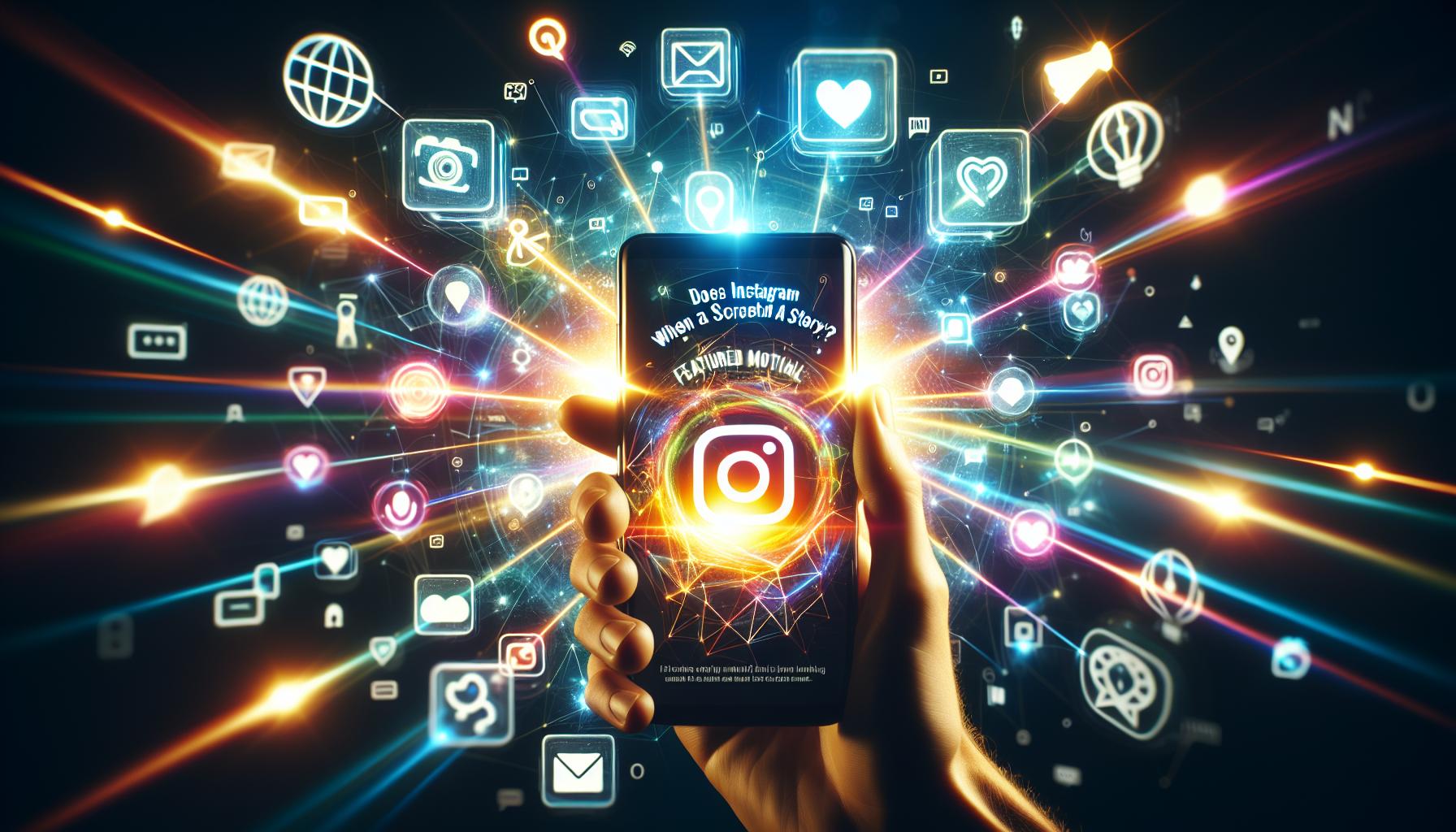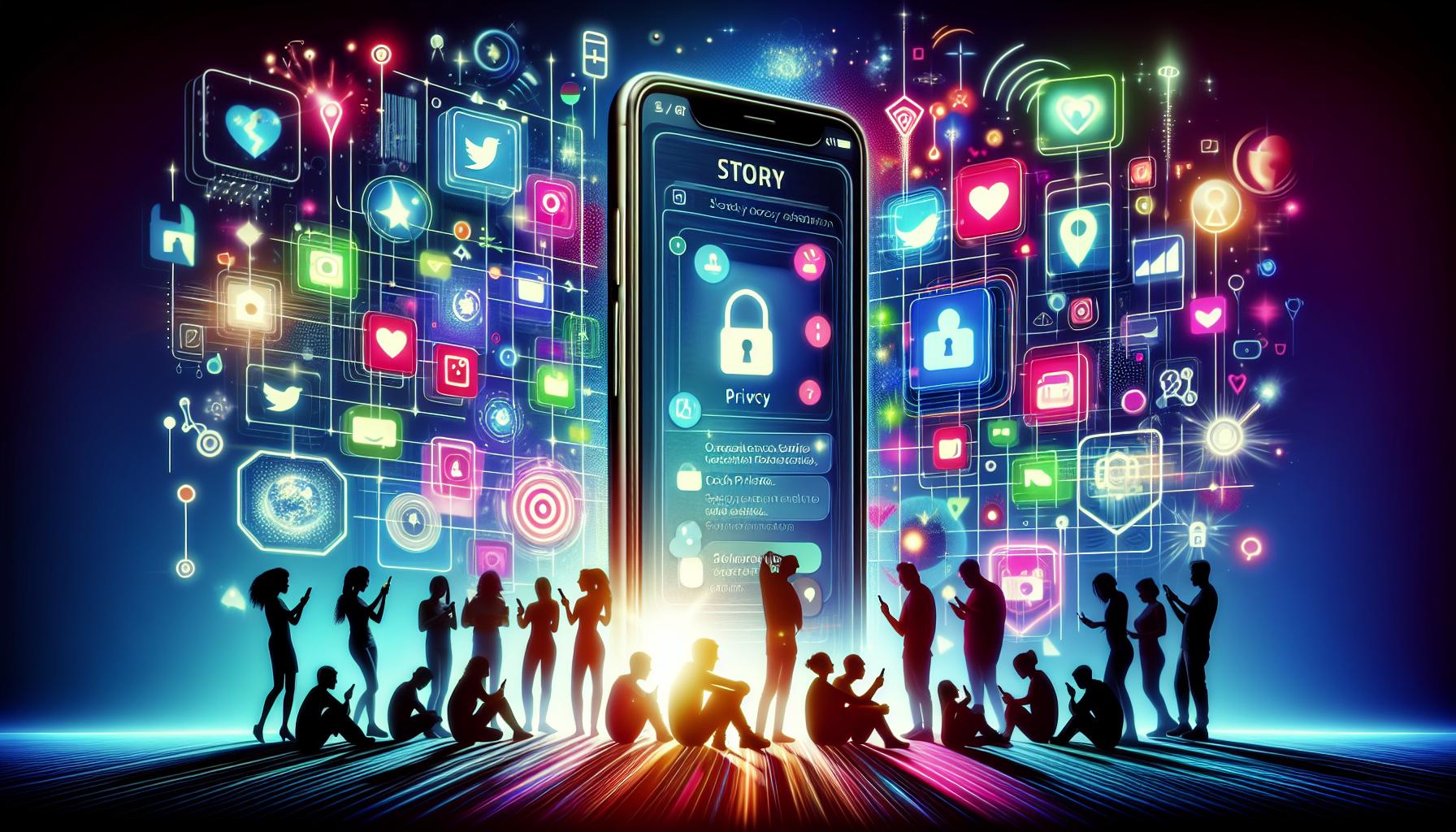In the evolving world of social media, understanding privacy and notification policies is essential, especially on platforms like Instagram. You might wonder: Does Instagram notify users when you take a screenshot of their Stories? This question is vital not only for personal users concerned about privacy but also for businesses and creators strategizing their content sharing.
Navigating Instagram’s notification landscape can be confusing, especially with features that seem to change frequently. Knowing whether your actions will alert others can shape how you engage with Stories, protect your content, and craft your marketing strategies effectively. Join us as we delve into Instagram’s screenshot notification policies, empowering you with the knowledge to use the platform confidently and strategically.
Does Instagram Notify When You Screenshot a Story?
When it comes to sharing snippets of life through Instagram Stories, many users wonder about the platform’s approach to privacy, particularly regarding screenshots. Currently, Instagram does not notify users if someone takes a screenshot of their Story. This means you can capture a moment from someone’s Story without fear of them being alerted. This lack of notification extends to all types of content shared in Stories, whether it’s images, videos, or polls. Users can relax knowing that their ephemeral content remains relatively private in terms of who can see it.
This policy is crucial for maintaining the spontaneous and casual nature of Stories, which are designed to be temporary and engaging. It encourages users to be more open and share unedited, real-life moments without worrying about the permanence of traditional feed posts. While users can comfortably take screenshots of these fleeting moments, it’s essential for all viewers to keep in mind the ethics of sharing content, especially if it pertains to private or sensitive situations.
However, there are exceptions to note. The only time Instagram does provide notification is when a screenshot is taken of a direct message that contains transient content, like disappearing photos or videos sent in Vanish mode. This creates a clear delineation between the casual sharing of Stories and the more private nature of one-on-one conversations. Understanding these distinctions can help users navigate the intricacies of Instagram’s privacy settings more effectively and ensure they respect the content shared by others.
Understanding Instagram’s Notification System
Navigating Instagram’s notification system can be a bit like deciphering a puzzle, especially when it comes to how it handles screenshots of ephemeral content. For many users, the ability to capture fleeting moments from Stories without triggering a notification is a significant relief. This feature enhances the spontaneous nature of sharing on Instagram, allowing users to save interesting content from the Stories of those they follow without worrying about alerting the original poster. This essentially promotes a more carefree and engaging interaction with content, where users feel liberated to share their real moments.
Understanding the finer points of Instagram’s notification policies is crucial for enjoying the platform while maintaining awareness of privacy and ethics. Essentially, Instagram has drawn a clear boundary between casual content and more intimate communications. While users can take screenshots of Stories-ranging from playful polls to captivating images-without any notification being sent, the rules shift dramatically for direct messages. If you capture a screenshot of a disappearing photo or video sent via direct message in Vanish Mode, the sender will be notified. This distinction highlights Instagram’s intention to protect personal exchanges and user privacy within its messaging features.
This nuanced approach means that users can feel more at ease when engaging with Stories, but it’s also important to exercise discretion. Respecting content created by others is essential, especially when it comes to private or sensitive material. As a best practice, before sharing a screenshot or passing on someone else’s content, consider whether the original creator would feel comfortable with the dissemination of their work. By fostering a culture of respect and awareness, users can enhance their Instagram experience while honoring the privacy of others, creating a healthier online community.
How Instagram Handles Story Privacy Settings
Navigating Instagram’s privacy settings, especially regarding Stories, is essential for users who want to maintain control over who sees their content and how it’s shared. Instagram has designed its features with a focus on user autonomy and safety, allowing individuals to curate their audience effectively. One key aspect of this is the ability to manage who can view your Stories, which is crucial as Stories represent more ephemeral and personal content compared to regular posts.
When creating a Story, users can select from several settings regarding who can view it. By default, your Stories are available to all your followers; however, you can adjust this through the privacy settings in your account. This means if you’re sharing something sensitive or personal, you can switch the visibility to only close friends. To do this, simply tap on your profile, navigate to “Settings,” select “Privacy,” and go to “Story.” Here, you can choose to restrict your Story views to specific individuals, offering a more intimate sharing experience. This customization empowers content creators to dictate their audience while enhancing their creative expression without the anxiety of wider exposure.
Moreover, users should be aware that while Instagram does not notify when you screenshot a Story, the platform still holds significance regarding user respect and privacy ethics. If you’re engaging with content that is fleeting by nature, consider the feelings of the original poster. Taking the moment to ask for permission or simply acknowledging the creator’s intent can foster a healthier environment on social media. Always remember, while the platform gives you tools for privacy, the responsibility to respect that privacy lies with each user, contributing to a more positive online community.
Ultimately, understanding how these privacy settings work can maximize your Instagram experience, allowing for greater creativity in sharing while safeguarding your peace of mind regarding unwanted attention. By staying informed and respectful, users can navigate Instagram’s evolving landscape effectively, ensuring their interactions remain positive and fulfilling.
Key Differences Between Stories and Feed Posts
The Instagram platform is a dynamic space where users engage with varying types of content, primarily through Stories and regular Feed posts. Understanding the key differences between these two forms of sharing is essential for optimizing user experience and effectively communicating with audiences. Stories are designed for quick, ephemeral interactions, disappearing after 24 hours, while Feed posts are permanent unless deleted and intended for more lasting communication.
One major distinction lies in visibility and engagement. When users post a Story, they can tailor who sees it through privacy settings, allowing them to share with selected followers or limiting access to a close friends list. This fosters a sense of intimacy and targeted communication, especially for sharing personal moments or content that users may not want their entire follower count to access. Conversely, Feed posts are visible to all followers (unless the account is private), making them ideal for broader engagement and more polished, often promotional content.
The interaction metrics also vary significantly. For Stories, users can see who viewed their content and even engage through direct messaging; however, they don’t receive feedback through likes or comments as they would on a Feed post. This creates a unique dynamic where Stories can prompt immediate conversation through DMs, fostering more direct connections, whereas Feed posts allow for public discussion and reactions. The transient nature of Stories often encourages spontaneous content creation, while Feed posts invite a more curated and thoughtful approach, catering to different storytelling styles and engagement strategies.
Moreover, the notification policies differ when it comes to capturing content. Instagram does not notify users when someone takes a screenshot of a Feed post, allowing for more discreet sharing. In contrast, if you screenshot a disappearing photo or video in a direct message, the original sender will be notified, enhancing the need for caution in those private interactions. Therefore, understanding these nuances is not only important for personal privacy but also essential for brands and creators looking to engage meaningfully with their audiences while respecting user boundaries and ensuring a positive community atmosphere.
What Happens When You Capture a Story?
Capturing a Story on Instagram can be an instinctive move, especially when you want to save or share a fleeting moment. However, understanding the implications of taking a screenshot is crucial to navigating the platform responsibly. When it comes to Instagram Stories, the good news is that you won’t trigger any notifications for the user who posted the Story. Unlike disappearing messages or media in direct messages-where the sender gets alerted-you can screenshot a Story without the original poster knowing.
When you capture a Story, it simply saves that moment to your device, allowing you to keep a record for personal use or to reference later. This feature can be particularly useful for content creators looking to gather inspiration or for brands keeping track of competitors’ engagements. Here’s a quick rundown of what happens when you screenshot a Story:
- No Notifications: The user who posted the Story will not be notified of your screenshot.
- Discreet Sharing: Since there are no alerts, it allows for a discreet way to capture and share content without the pressure of the original creator’s knowledge.
- Potential Privacy Concerns: Always remember that while you can screenshot Stories without notifications, consider the intentions behind capturing someone else’s content and respect their creative rights.
This capability can lead to a healthy dialogue about privacy and creative ownership. It’s essential to be mindful of the content you’re capturing as users can share intimate or personal moments through Stories, often designed for a selective audience. Instead of taking a screenshot impulsively, think about reaching out to the creator if you enjoy their content; they may appreciate the engagement and authenticity of your interest.
Ultimately, while the notification-free zone surrounding screenshots of Stories might offer flexibility for users, consciously considering the impact of sharing or saving someone’s fleeting content is vital in fostering a respectful online community. If you find yourself frequently drawing inspiration from others’ Stories, think about utilizing Instagram’s direct message feature to ask for permission or engage directly with the creator. By doing so, you cultivate a more transparent and trusting relationship on the platform.
Debunking Common Myths About Story Screenshots
The common sentiment surrounding Instagram Stories is steeped in misconceptions, particularly when it comes to the idea of taking screenshots. One of the most pervasive myths is that users are notified if someone screenshots their Story. The reality, however, is quite different. When you capture a Story on Instagram, the original poster won’t receive any notification about the screenshot, allowing users to take these snapshots with a level of security that silences the rumor mill surrounding privacy breaches.
Another myth revolves around the idea that screenshotting a Story somehow violates the platform’s policy or the creator’s rights. While it’s true that capturing someone’s content without their permission can raise ethical questions, Instagram does not penalize users for simply taking screenshots of Stories. However, being aware of the content you are capturing and the context behind it is crucial. For instance, if someone shares personal or sensitive moments in their Story, it’s respectful to consider their privacy before taking a screenshot. Engaging with creators-by asking for permission or sharing your appreciation-can pave the way for healthier interactions and community connections.
Moreover, users often believe that a certain “feature” exists that prevents them from taking screenshots of Instagram Stories without facing consequences. While this perception might stem from users’ experience with other ephemeral messaging apps, it’s essential to understand that Instagram operates differently. Unlike direct messages in Vanish Mode, where notifications are sent upon screenshots, Stories allow for uninhibited sharing of moments without alerting the message sender; this feature emphasizes the unique nature of Stories.
In light of these misunderstandings, it’s important for users to be educated about the actual norms and possibilities within Instagram’s ecosystem. As users become more aware, they can navigate the platform more effectively, building a culture of respect and understanding around content sharing. The depth of insight into how Instagram operates not only enriches the user experience but helps maintain the integrity of the community as a whole.
Why Users Are Concerned About Story Privacy
In an age where digital interactions are meticulously curated, users often voice their concerns regarding the privacy of their shared content on Instagram Stories. When someone shares a fleeting moment through a Story, they may feel a sense of vulnerability, knowing that this content disappears after 24 hours. This temporality combined with the potential for screenshots amplifies worries about unauthorized sharing and misuse of personal moments, especially when sensitive information or emotions are involved.
One significant factor contributing to these privacy concerns stems from the nature of the content typically shared in Stories. Users frequently showcase personal highlights, behind-the-scenes glimpses, or candid moments that carry emotional weight. The fear of someone capturing these moments without consent can deter users from expressing themselves freely. This anxiety is often reinforced by social media discourse, where stories of misuse, such as sharing screenshots in a harmful context, circulate widely, leaving a lasting impression on users’ behavior.
Moreover, the distinction between different types of content on Instagram further complicates privacy perceptions. Unlike posts that remain visible on a user’s profile, Stories are ephemeral, creating a false sense of security. Users may mistakenly believe that disappearing content is less likely to be captured, leading to a false sense of privacy. Additionally, the absence of a notification feature when screenshots are taken contributes to a culture of uncertainty. Users are left wondering if they can truly share intimate details without risking their trust.
To navigate these privacy concerns effectively, users should be proactive about their settings and audience. Here are a few practical strategies:
- Adjust Audience Settings: Regularly review who can see your Stories. Utilizing close friends lists can help limit sharing to a trusted circle.
- Use Privacy Features: Familiarize yourself with Instagram’s privacy settings, such as blocking certain users from viewing your Stories.
- Be Cautious with Sensitive Content: Think carefully before sharing personal stories or images that could be misinterpreted or misappropriated.
Understanding these dynamics is crucial for fostering a community where individuals feel safe to express themselves while respecting others’ privacy as well. Engaging with your audience, whether through direct messages or interactive Story features like polls, can create a sense of connection that fosters trust, reducing anxiety over potential unauthorized screenshots.
User Reactions: What Happens When You Screenshot?
When someone captures a screenshot of an Instagram Story, the original poster remains blissfully unaware. Unlike posts shared in feeds, Instagram does not notify users when someone screenshots their Stories. This can lead to a mix of emotions among users; some may feel a sense of relief that their temporary content isn’t being monitored, while others might feel a twinge of anxiety at the possibility of unauthorized copies of their private moments being circulated or misused.
The reality is that users need to be aware of this potential for screenshots, especially considering the personal nature of content frequently shared in Stories. When users do not receive notifications about screenshots, it can lead to situations where private moments are shared beyond their intended audience. For instance, a user might post a Story showcasing a celebration or a candid moment that carries emotional weight-without realizing that someone could discreetly capture and share that moment, potentially impacting the original poster’s privacy and reputation.
Moreover, reactions to screenshots vary widely among users. Some may choose to confront individuals about their actions, encouraging open conversations about privacy and consent, while others might adopt a more relaxed attitude, believing that once content is shared online, control over it is inherently lost. This dichotomy reflects broader societal views on digital privacy; understanding an individual’s reaction to the potential of screenshots can inform how users engage with the platform and navigate their own privacy preferences.
To empower users, it’s essential to encourage mindfulness when sharing Stories. Considering the audience and visibly managing privacy settings can help mitigate the discomfort surrounding screenshots. Users can take proactive steps, such as creating close friends lists or setting stricter Story visibility settings, to foster a sense of control over who sees their content. Engaging in this thoughtful approach not only enhances individual comfort but also cultivates a community of trust and respect for shared narratives on the platform.
Future Updates: Changes to Instagram Notification Policies
As Instagram continues to evolve, users are keenly interested in how shifts in policies might impact their storytelling and content-sharing experience, particularly regarding notifications for screenshots of Stories. Currently, Instagram does not notify users when someone captures a screenshot of their Story, a feature designed to encourage spontaneous sharing without the anxiety of being monitored. However, the platform is known for refining its features in response to user feedback and trends in digital privacy, which invites speculation about possible future updates to this notification policy.
One potential change that users are hoping for involves more nuanced privacy options. Many users express a desire for clearer, more robust settings that allow them to see when their content has been captured, ultimately empowering them to make informed decisions about the visibility of their Stories. For example, Instagram could implement a feature where users can opt in to receive notifications for screenshots taken of their Stories, similar to how notifications work in Direct Messages. This would offer a layer of transparency that could alleviate concerns regarding unauthorized sharing of personal content.
Furthermore, as awareness around digital privacy increases globally, Instagram may also consider creating more educational resources to inform users about how their content is being shared and what rights they have. Enhancing the user experience through better privacy controls could align Instagram with broader industry trends emphasizing user agency and digital consent. Users might appreciate tutorials or in-app prompts that encourage them to review privacy settings before posting, fostering a more secure environment in which they can share candid moments without fear.
Overall, any future updates to Instagram’s notification policies will likely focus on balancing user engagement with privacy concerns. By adapting to the needs of its user base, Instagram can continue to be a platform where creativity flourishes while respecting the boundaries of personal content sharing. As these changes develop, remaining informed and proactive about managing privacy settings will be vital for users looking to protect their Stories in an evolving digital landscape.
Tips for Respecting User Privacy on Instagram
Maintaining privacy on social media platforms like Instagram is crucial, especially in an era where sharing goes hand in hand with potential consequences. One of the common concerns users face is what happens when someone screenshots their content. While Instagram currently does not notify users when someone takes a screenshot of their Story, it’s important to adopt practices that respect privacy and promote transparency among your followers. Here are key strategies to help you navigate privacy on Instagram, particularly concerning your Stories.
Review Your Audience Settings
One of the simplest ways to safeguard your content is by managing who can view your Stories. You can choose to share your Stories with all of your followers, specific friends, or close friends. To do this, go to your profile page:
- Tap the three horizontal lines in the upper right corner to open the menu.
- Select Settings, then Privacy.
- Under the Interactions section, choose Story, where you can adjust who sees your Stories.
By customizing your audience, you can significantly reduce the risk of unauthorized viewing and sharing of your content.
Utilize Story Controls
Instagram offers features that allow you to control your Stories further. For instance, consider using the Hide Story From option, which lets you select specific followers who won’t see your Stories:
- While in the Story settings, tap Hide Story From and select the users you want to exclude.
- You can also toggle off Allow Resharing to Stories if you want to prevent others from sharing your Story further.
Being proactive with these controls helps you manage your content’s visibility effectively.
Think Before You Post
Content posted on social media is, by nature, shareable. Before uploading a Story, consider whether the content is something you would feel comfortable sharing with a broader audience. This includes personal photos, sensitive information, or anything that may not be appropriate for all your followers. If you’re hesitant, it may be wise to rethink posting that particular Story.
Educate Your Followers
Instill a culture of respect among your followers by communicating openly about privacy needs. You might leave a note in your Stories, like “Please don’t screenshot,” which sets a friendly yet clear expectation. This empowers your followers to respect your wishes and understand your preferences when it comes to privacy.
By applying these strategies, users can better protect their content on Instagram while fostering a more considerate community. Acknowledging the inherent risks while leveraging available privacy features ultimately leads to a more enjoyable and secure Instagram experience. Always stay informed about new updates to Instagram’s policies, as the platform may enhance user privacy capabilities over time.
Alternatives to Sharing Screenshots of Stories
While capturing a moment through a screenshot may seem like the easiest way to share enticing Instagram Stories, there are alternatives that respect user privacy while also enhancing communication and engagement. Understanding these options not only helps maintain trust in your interactions but also encourages more creative sharing methods.
One effective alternative is to utilize Instagram’s built-in sharing features. Instead of taking a screenshot, you can directly share the Story by tapping the paper plane icon beneath the post. This option allows you to send the Story to specific friends via Direct Message, ensuring that your intent to share is understood and acknowledged. This method fosters a sense of involvement and consideration, making your followers feel more valued and less like passive observers.
Another creative approach is to use the “Create” function for your Stories. This feature enables you to produce visually appealing content using text and graphics without needing to capture existing images. Tap the camera icon, select the ‘Create’ mode, and personalize your Story with words, colors, and stickers. This allows you to convey the intended message without relying on someone else’s original content. Furthermore, inviting your followers to participate actively in your Stories can also enhance engagement. For example, you could post a poll or a question sticker, encouraging discussions while keeping your content dynamic and interactive.
For those who still want to reference someone else’s content, Instagram allows users to mention others by tagging them in a Story. This respectful method not only gives credit where it’s due but also invites the person whose content you admire to engage with your Story as well. Simply tap on the text icon, type “@” followed by their username, and it will create a clickable link for viewers.
Lastly, consider using screen recording as an alternative to screenshots for capturing Stories, particularly your own. This feature allows you to compile various moments into a single clip, ready for sharing across platforms. However, remember to use this tool ethically-only record and share content that you own or have permission to share.
By adopting these strategies, you can maintain the integrity of personal content and foster a respectful community on Instagram. Embracing creative sharing methods not only enhances user experience but also upholds the fundamental values of privacy and respect within your social network.
Maximizing Your Instagram Experience Without Compromising Privacy
Navigating Instagram effectively while respecting privacy can transform your social media experience into a more meaningful engagement. One of the most critical aspects of using Instagram Stories is knowing how to interact with others’ content without compromising their privacy or your own. For example, instead of capturing someone’s Story through a screenshot, utilize the built-in sharing features. Simply tap the paper airplane icon below the Story to send it directly to friends via Direct Message. This not only preserves the original intent of the content but also allows for a more personal touch in your interactions, reinforcing a sense of community.
Another method to showcase creativity and engage with your audience is by leveraging Instagram’s “Create” function. This feature allows you to make unique content by adding text, colors, and stickers without needing to replicate existing Stories. To access this feature, tap on the camera icon, select ‘Create’ mode, and let your imagination flow. By doing so, not only do you respect the integrity of original content, but you also create something that reflects your style and engages your followers.
If you wish to reference someone else’s content appropriately, Instagram allows for tagging in Stories. By typing “@” followed by the username, you create a clickable label that acknowledges the original creator. This encourages interaction and keeps the platform focused on collaboration rather than appropriation, which builds trust among users. Remember, engagement is more than just sharing; it’s about fostering a nurturing community where all creators feel valued.
Lastly, using the screen recording feature is an efficient way to capture your Stories, especially for your creations. This tool allows you to compile clips, making it easier to share your moments across different platforms. Still, ethical use is essential. Only record and share media you own or have permission to avoid future conflicts. By adopting these practices, you can maximize your Instagram experience while fostering a respectful and engaging environment that celebrates creativity and protects user privacy.
Frequently Asked Questions
Q: Does Instagram notify users when someone takes a screenshot of their story?
A: No, Instagram does not notify users when someone screenshots their story. Unlike Snapchat, Instagram allows screenshotting stories without any alerts being sent to the original poster, ensuring user privacy regarding regular posts and stories.
Q: What notifications do you receive if someone screenshots your Instagram chat?
A: If someone takes a screenshot of a chat while in vanish mode, Instagram notifies both users with a message stating that a screenshot has been taken. Regular DMs do not trigger any notifications for screenshots.
Q: Can you see who has viewed your Instagram story?
A: Yes, Instagram allows users to see who viewed their stories. By swiping up on the story, you can view the list of users who have seen it, but this does not include notification of any screenshots taken.
Q: Are there any differences between Instagram stories and feed posts regarding screenshots?
A: Yes, the main difference is notification. Instagram does not notify users when screenshots are taken of feed posts, similar to stories. However, viewing stories allows users to see who views them, unlike regular posts.
Q: Can I save someone’s Instagram story without them knowing?
A: Yes, you can take a screenshot of someone’s Instagram story without them being notified. There are also third-party applications that allow you to download stories directly, but this activity should be approached carefully to respect privacy.
Q: What happens if I screenshot an Instagram story before it disappears?
A: When you screenshot an Instagram story, the person who posted the story does not receive any notifications. However, the story will still disappear after 24 hours unless saved to highlights.
Q: Why are users concerned about Instagram story privacy?
A: Users are often concerned about privacy on Instagram stories due to the fear of screenshots or unauthorized sharing of their content. Users want assurance that their personal content is protected and that their interactions remain private.
Q: Will Instagram ever change its notification policy for screenshots?
A: While there’s no current indication that Instagram will change its screenshot notification policy, keeping an eye on updates is essential. The platform frequently evolves, so monitoring official announcements is recommended to stay informed.
Final Thoughts
Now you have a clearer understanding of Instagram’s policy on screenshot notifications for Stories. Remember, while Instagram does not notify users when someone screenshots their Story, being mindful of privacy is essential. If you found this insight helpful, be sure to explore related topics in our articles about protecting your privacy on Instagram and maximizing engagement through Stories.
Don’t miss out-subscribe to our newsletter for the latest updates and expert tips on navigating Instagram like a pro. Whether you’re a casual user or a content creator aiming for wider reach, we have resources tailored just for you! Have questions or experiences to share? Leave a comment below and join the conversation. Your engagement helps us provide the best content!




